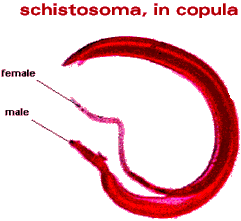Commonly known as blood flukes, these parasites infect an estimated 200 million people throughout Africa, Southeast Asia, South America, and certain islands of the Caribbean, causing one million deaths per year.

Blood fluke eggs hatch in water, and anyone who comes into contact with this water usually becomes infected because the newly-hatched worms are able to burrow through human flesh. In other words, they can enter your body by digging through exposed skin--such as the bottoms of your feet.
One common strain of this parasite, Schistosoma Japonicum, causes coughing, fever, diarrhea, and anemia. It has also been known to cause radical shifts in body composition such that the abdomen inflates with liquid while the limbs and the rest of the body waste away. Other symptoms include bloody urine or feces from damage to the bladder and/or small intestine, and pneumonia from the infection of the lungs.

